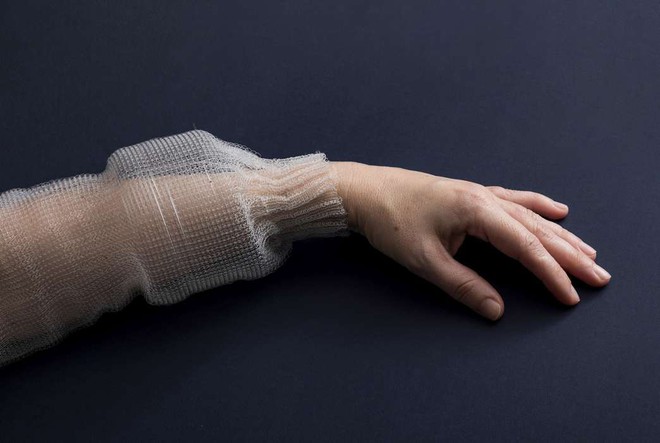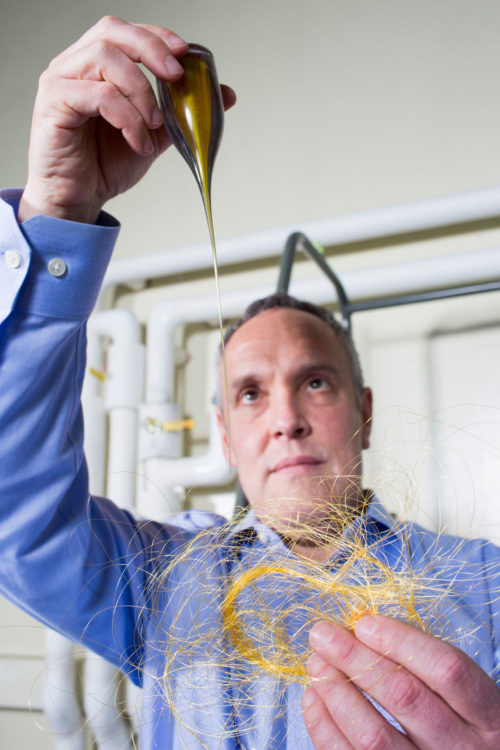Successful development of digital fabric: data storage and analysis, music and movies can be saved on clothes
- Tram Ho
Scientists at the Massachusetts Institute of Technology (MIT) have successfully designed a type that can only store digital information, which can be embroidered into ordinary clothing. According to experts, this is the first product in the world with this miraculous ability.
This digital fabric can store music, video, and other files, and even the fabric has the ability to collect physiological data to analyze and predict the wearer’s body activity. The healthcare industry will be wearing a new shirt, embroidered by multi-tasking electronic fabrics.

The electronic thread forms the digital fabric, which can store and process information.
In a new report published in the journal Nature , the scientists explain that the digital fabric uses a communication protocol with two letters 0 and 1, similar to how computer systems work. This ability sets the new fabric apart from previously made electric fabrics, which operate on electric currents but are not capable of transmitting and storing data.
More notably, the MIT-built digital fabric can connect to multiple devices, allowing a single shirt to perform many different functions. Yoel Fink, a professor of materials science at MIT and a study author, says his report focuses on taking garment engineering to the next level.
“ Fabric does its job, ” says Professor Fink. “ So my research is an attempt to blend the world of device with the world of functionality, new direction for fabrics and tie them to high-tech equipment .”
He continued: “ This is an important development chapter, the first time that electronics have penetrated deep into the fabric. You can put memory into the fabric, that is, you have transferred information into it. That means you can program and store processing systems as well as a lot of other valuable information .”

Yoel Fink.
Mr. Fink and his colleagues have successfully developed a prototype of this digital-only thing. It is flexible and thin enough to be threaded through the eye of a needle and embroidered onto clothing. “ Basically, the idea was to put a digital processing chip in the fabric, and we did that .”
The process of making a strand involves placing hundreds of square silicon microchips onto a large rectangular plate called a “preform”. The scientists heated the preform, causing the chip to melt into a long strand, and the chips on the fiber were all connected by electric current.
The thread is embroidered into the armpits of the shirt and draped over the test group, so that the digital fabric touches the wearer’s skin. Combining this high-tech shirt with an artificial intelligence network, the digital fabric can measure the temperature of test participants, identify the physical activity they are doing (such as sitting, standing, walking, etc.) ) with an accuracy of up to 96%. Besides, researchers can also record, store and read information on the fabric.
They have successfully saved on canvas two files, a short film and a soundtrack; The file lasts for two months without power. The digital cloth also withstands 10 washes before it fails.

An illustration of the possibilities of a digital fabric.
“This is a scientific work, so we don’t necessarily have to think about practical applications right away, but we are trying to think in two directions. One is a bit abstract, which is to add information and depth to something that doesn’t have both, which is a piece of cloth, ” says Professor Fink. “ Will this act change the way we think and interact with the cloth, when we know it can hold something, like a book, a piece of music or a piece of text? ”
As for the second line of thought, Mr. Fink thinks there will be an application for this digital fabric. The professor believes that each person’s body is an individual’s property, and the new fabric will make us use this asset even more fully.
” The body sends out a lot of information that we can’t hear, don’t receive ,” he said, referring to data related to the body’s fitness and inner workings that are not easily measured. To collect this data, clothes need sensors, but we still need an efficient way to store and analyze the data. The new fabric has satisfied the above demand.
“ I think the biggest application of digital fabrics will be in the healthcare industry – turning medical care from routine check-ups to continuous monitoring, ” said Professor Fink. Moreover, clothes are indispensable things on people when going out, so wearing “smart clothes” will be more convenient than wearing smart devices, such as smartwatches.
Currently, the team is continuing to perfect the product, with the hope of launching the first practical application soon.
According to The Academic Times
Source : Genk
